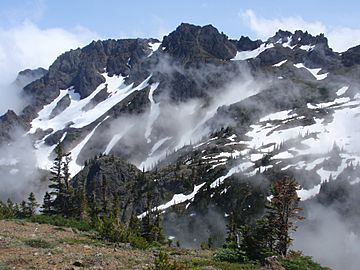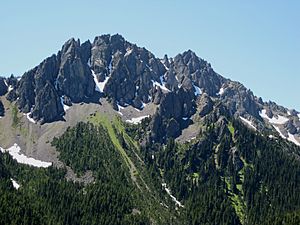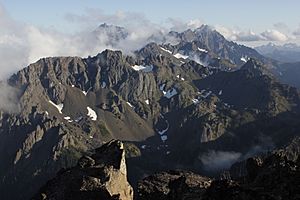Boulder Ridge facts for kids
Quick facts for kids Boulder Ridge |
|
|---|---|

Boulder Ridge, north aspect, seen from the Marmot Pass area
|
|
| Highest point | |
| Elevation | 6,852 ft (2,088 m) |
| Prominence | 572 ft (174 m) |
| Geography | |
| Location | Buckhorn Wilderness Jefferson County, Washington, US |
| Parent range | Olympic Mountains |
| Topo map | USGS Mount Townsend |
| Geology | |
| Age of rock | Eocene |
| Type of rock | Tilted pillow Basalt |
| Climbing | |
| Easiest route | Marmot Pass class 2 Scramble |
Boulder Ridge is a cool mountain ridge in the eastern Olympic Mountains in Washington state. It stands about 6,852-foot (2,088-metre) (that's around 2,088 meters) tall! This ridge is part of the beautiful Buckhorn Wilderness. It's also managed by the Olympic National Forest.
Nearby, you'll find Alphabet Ridge about 0.94 mi (1.51 km) to the south. Buckhorn Mountain is also close, rising 1.3 mi (2.1 km) to the north. Water from Boulder Ridge flows into different rivers. Some water goes east to the Big Quilcene River. Other water flows west to the Dungeness River. Water also drains south into Charlia Lakes and then Tunnel Creek.
Weather at Boulder Ridge
Boulder Ridge is in a special climate zone called the marine west coast. This means it gets a lot of weather from the Pacific Ocean. Big weather systems, called weather fronts, travel from the ocean. They move northeast towards the Olympic Mountains.
When these fronts hit the tall Olympic peaks, they are forced to rise. This makes them drop their moisture as rain or snow. This process is called Orographic lift. Because of this, the Olympic Mountains get a lot of rain and snow. This is especially true during the winter months.
During winter, it's often cloudy. But in summer, high pressure systems over the Pacific Ocean bring clear skies. This means there's often little or no cloud cover. The snow here tends to be wet and heavy. This can sometimes create a risk of avalanches. The best time to visit or climb Boulder Ridge is usually from July to September. The weather is much nicer then!
How Boulder Ridge Formed
The Olympic Mountains are made of special rocks. These rocks were pushed up from the ocean floor. They are mostly Eocene sandstone, turbidite (a type of sedimentary rock), and basalt (a volcanic rock).
Over a very long time, during the Pleistocene era, glaciers helped shape these mountains. These huge ice sheets moved forward and then melted back many times. Each time, they carved out the valleys and peaks we see today.





